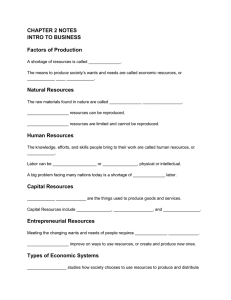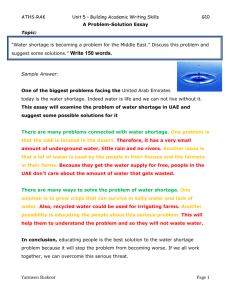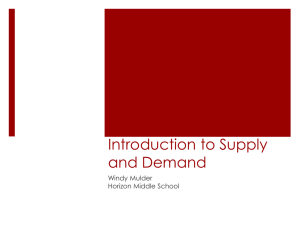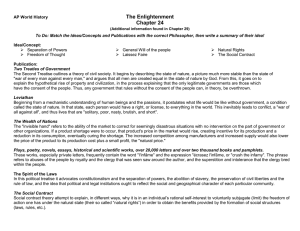oromia group work report- Abule - LIVES
advertisement
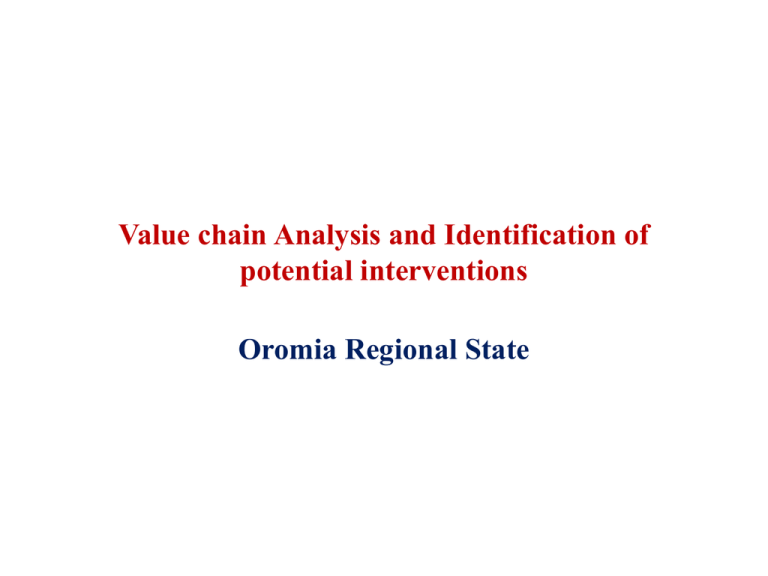
Value chain Analysis and Identification of potential interventions Oromia Regional State Group members 1. Ato Tadesse Kudhema 2. Ato Seyoum Etana 3. Dr. Amenu Oljira 4. Ato Awol Sultan 5. Ato Tesefaye Moreda 6. Dr. Bultuma Keno 7. Dr. Tilahun Geleto 13. Dr. Ephrem Tesema Group members 8. Ato Edossa Etissa 9. Ato Abera Ketema 10. Ato Andarge Senbeta 11. Ato Nigatu Alemayehu 12. Dr. Abule Ebro A. Dairy I. Break up the value chain into its constituent parts/stages 1.1. Input supply • Heifers (Local and cross-bred) • Feed (cut and carry, concentrate, crop residues, urea molasses, and etc ) • Chopper • Feeding and water troughs • Drugs, vaccines and veterinary facilities • Finance/Credit service • Milking equipments and utensils A. Dairy 1.2. Production • Management (Shelter, health, feeding, breeding) • Milk quality 1.3. Transportation 1.4. Storage 1.5. Processing/Packing (Cheese, Butter and Ergot) 1.6. Marketing Collection centers Market information Selling price Market infrastructure Quality and standards A. Dairy II. Identify the functions of the chain actors at the different stages 2.1. Producers ( Produce milk and milk products) Small holder farmers (Producers, Cooperatives (Producers, milk collection, 2.2. Input suppliers (supply of inputs) – Private – Livestock Agency – Research centers (Not continuous) – EMDTI (Not frequently) – Universities (Not frequently) – NGOs (Not frequently) A. Dairy – Smallholders 2.3. Processors – Private – Cooperatives` – Smallholders (Cheese, Butter) 2.4. Marketing – Private (produce/process/collect/process) – Cooperatives – Retailers (Hotels, restaurants, cafeterias, – Whole sellers (Butter) A. Dairy III. Identify the services provided and the services providers at each stage of the chain 3.1. Services provided • Veterinary service • Genetic material (AI service, Bull and etc) • Extension service (field-day and advisory) • Credit service • Capacity building (education, short term training, tour, on job training ) • A. Dairy 3.2. Service providers • Public – Livestock Agency – NVI – Sebata Laboratory – EMDTI – Oromia ARI – EIAR – FVM (Addis Ababa University) – Universities – Others • Community AI technicians (Arsi zone, East Shewa, etc) • Private sector • NGO A. Dairy IV. Develop a vision/model of the value chain “If you don’t know where you are going, any road will take you there” Vision: Improved/increased production and productivity of dairy farms of small holder farmers (Male and Female household) that increase the economic benefits and livelihoods through proper value chain on sustainable natural resource basis. • A. Dairy Enhancing the production and productivity of dairy cattle – Local from 1.5 to 3.25 litres/cow/day – Cross from 8.2 to 12 litres/cow/day Actor Input supplier Vision Provision of inputs in the required quantity, quality, affordability and timely for the value chain system Provide quality and quantity inputs timely which will satisfy the target groups Service providers Market infrastructure (To establish sustainable market for the smallholder farmers Effective and efficient service delivery system on sustainable base in the value chain system The private sector should be ready to provide services in accordance with the needs of dairy farmers Empowerment of the private sector through proper policy and strategy in accordance with the needs of dairy farmers A. Dairy • V. Identify constraints and opportunities and opportunities to realize the vision 5.1. Constraints • 5.1.1. Input – Shortage of improved dairy cattle (Local and improved) – Shortage of feed in quantity and quality (Basic seed, timely, – Shortage of veterinary inputs (drugs, vaccine, equipment and etc) – Shortage of genetic materials (AI, bull service, liquid nitrogen, semen, etc) – Shortage of milking utensils/equipment A. Dairy 5.1.2. Production – Poor husbandry and management (Shelter, health, feeding, breeding, Milk quality and etc) 5.1.3. Shortage of Transportation (Standard vehicle shortage, 5.1.4. Shortage of storage (Cooling) facilities 5.1.5. Shortage of Processing/Packing materials 5.1.6. Marketing (shortage of • Collection centers • Market information • High cost of inputs (Unfair selling price) • Market infrastructure • Poor Quality and lack of proper standards • Less involvement of cooperatives in A. Dairy Shortage of skilled manpower 5.2. Opportunities – Policy and strategy – Demand – Income growth of consumers VI. Identify the required knowledge and capacities to realize the vision • AI, cooperatives, finance, credit, service, skilled manpower, training and education, facilities (field and laboratory), transportation and storage, updated market information and etc) A. Dairy VII. Identify the required services to realize the vision Services Indicated on above VIII. Identify the required enabling environment conditions to realize the vision • Policy and strategy • Responsibility and commitment • Expansion of infrastructure B. Poultry I. Break up the value chain into its constituent parts/stages 1.1. Input supply • Chicken (day old, layer and broiler) • Feed (Concentrate, ) • Drugs, vaccines and veterinary facilities • Finance/Credit service • Poultry equipments like waterer, feeder, brooder, incubator, and etc 1.2. Production • Management (Shelter, health, feeding, parent stock, egg and meat quality) B. Poultry 1.3. Transportation 1.4. Storage 1.5. Processing/Packing (Dressing, 1.6. Marketing – – – – Market information Selling price Market infrastructure Quality and standards B. Poultry II. Identify the functions of the chain actors at the different stages 2.1. Production – Small holder farmers (Producers, – Cooperatives (Producers, 2.2. Input suppliers – Private – Livestock Agency – Research centers (Not continuous) – Universities (Not frequently) – NGOs (Not frequently) – Smallholders B. Poultry 2.1.4. Processors – Private – Cooperatives (Non existent) 2.1.5. Marketing – Private – Cooperatives – Retailers (Hotels, restaurants, cafteria – Whole sellers (egg, chicken) III. Identify the services provided and the services providers at each stage of the chain B. Poultry 3.1. Services provided • • • • • Veterinary service Genetic material (chicken) Extension service (field-day, advisory) Credit service Capacity building (education, short term training, tour, on job training ) B. Poultry 3.2. Service providers 3.2.1. Public – Livestock Agency – NVI – Sebata Laboratory – Oromia ARI – EIAR – Universities – Others 3.2.1. Private sector 3.2.3. NGO B. Poultry IV. Develop a vision/model of the value chain Improved/increased production and productivity of poultry farms of small holder farmers (Male and Female household) that increase the economic benefits and livelihoods through proper value chain with a balanced supply of cereal production (Human competition). • Local from 50 to 70 eggs/year/chick • Exotic from 140 to 280 eggs/year /chick Actor Input supplier Vision Provision of inputs in the required quantity, quality, affordability and timely for the value chain system Provide quality and quantity inputs timely which will satisfy the target groups Service providers Market infrastructure (To establish sustainable market for the smallholder farmers Effective and efficient service delivery system on sustainable base in the value chain system The private sector should be ready to provide services in accordance with the needs of poultry farmers Empowerment of the private sector through proper policy and strategy in accordance with the needs of poultry farmers B. Poultry V. identify constraints and opportunities and opportunities to realize the vision 5.1. Constraints 5.1.1. Input – Shortage of improved parent stock, day old chick, pullets, broiler and layers – Shortage of feed in quantity and quality ( timely, – Shortage of veterinary inputs (drugs, vaccine, equipment and etc) – Shortage of poultry equipments B. Poultry • 5.1.2. Production – Poor husbandry and management (Shelter, health, feeding, breeding, quality and etc) 5.1.3. Mode of transportation 5.1.4. Shortage of storage (chilling and Cooling) facilities 5.1.5. Shortage of Processing/Packing materials 5.1.6. Marketing – Collection center (Lack) – Market information (Shortage) – High cost of inputs – Market infrastructure (lack) – Poor Quality and lack of proper standards – Less involvement of cooperatives Shortage of skilled manpower B. Poultry 5.2. Opportunities • Policy and strategy • Demand • Income growth of consumers B. Poultry VI. Identify the required knowledge and capacities to realize the vision Cooperatives, finance, credit, service, skilled manpower, training and education, facilities (Field and laboratory), transportatio and storage, updated market information and etc) VII Identify the required services to realize the vision • Services • Indicated on above B. Poultry • VIII. Identify the required enabling environment conditions to realize the vision • Policy and strategy • Responsibility and commitment • Expansion of infrastructure C. Apiculture • I. Break up the value chain into its constituent parts/stages 1.1. Input supply • Bee Colony, Bee hive • Feed (Bee forage) • Drugs and veterinary facilities • Finance/Credit • Bee equipment and accessories • Foundation sheet 1.2. Production • Management (Shelter, health, feeding, Queen rearing and colony splitting) • Honey, wax, pollen, propolis, bee venom quality C. Apiculture 1.3. Transportation 1.4. Storage 1.5. Processing/Packing 1.6. Marketing – Collection centers – Market information – Selling price – Market infrastructure – Quality and standards C. Apiculture II. Identify the functions of the chain actors at the different stage • 2.1. Producer – Small holder farmers (Producers, – Cooperatives/Micro enterprises (Producers, honey and wax collection) • 2.2. Input suppliers – – – – – – – Private Livestock Agency Research centers (Not continuous)`` Universities (Not frequently) NGOs (Not frequently) Smallholders MSE C. Apiculture 2.1.4. Processors – Private – Cooperatives – Smallholders 2.1.5. Marketing – Private (produce/process/collect/process) – Cooperatives – Retailers (Tej bête, cafeteria, Hotels, restaurants) – Whole sellers (Honey and wax) C. Apiculture III. Identify the services provided and the services providers at each stage of the chain Services provided 3.1. Services provided • Queen rearing and colony splitting • Extraction • Extension service (field day and advisory) • Credit service • Capacity building (education, short term training, tour, on job training ) C. Apiculture 3.2. Service providers • Public – Livestock Agency – Oromia ARI – EIAR – Universities – Others (Ethiopian bee keepers association) • Private and cooperatives • NGO C. Apiculture IV. Develop a vision/model of the value chain Vision: Improved/increased production and productivity of Apiculture of small holder farmers (Male and Female household) that increased the economic benefits and livelihoods through proper value chain on sustainable natural resource basis. Enhancing the production and productivity of Apiculture – Traditional hive 5 to 8 kg/hive – Transitional 11 to 20 kg/hive – Modern 25 to 40 kg/hive Actor Input supplier Vision Provision of inputs in the required quantity, quality, affordability and timely for the value chain system Provide quality and quantity inputs timely which will satisfy the target groups Service providers Market infrastructure (To establish sustainable market for the smallholder farmers Effective and efficient service delivery system on sustainable base in the value chain system The private sector should be ready to provide services in accordance with the needs of beekeepers Empowerment of the private sector through proper policy and strategy in accordance with the needs of bee keepers C. Apiculture V. Identify constraints and opportunities and opportunities to realize the vision 5.1. Constraints • 5.1.1. Input – Shortage of colonies, wax, – Shortage of feed in quantity and quality (Basic bee forage seed) – Absence of veterinary inputs and services – Shortage of bee equipment (hives/accessories, foundation sheet • 5.1.2. Production – Poor husbandry and management (Shelter, health, feeding, , honey and wax quality etc) C. Apiculture 5.1.3. Shortage of storage, post harvest handling 5.1.4. Shortage of Processing/Packing materials 5.1.5. Marketing Constraints – Collection centers – Market information – High cost of inputs (Unfair selling price) – Market infrastructure do not have separate slot in the shops for the product – Poor Quality and lack of proper standardization – Less involvement of cooperatives in marketing • Shortage of skilled manpower • Environmental constraints: improper utilization of agro chemicals C. Apiculture 5.2. Opportunities Policy and strategy Demand Income growth of consumers VI. Identify the required knowledge and capacities to realize the vision • Cooperatives, finance, credit service, linkage among chain actor, skilled manpower, training and education, facilities (Field and laboratory, transportation and storage, updated market information and etc) C. Apiculture • VII. Identify the required services to realize the vision – Indicated on above VIII. Identify the required enabling environment conditions to realize the vision – Policy and strategy – Responsibility and commitment – Expansion of infrastructure – Proper standardization and certification D. BEEF I. Break up the value chain into its constituent parts/stages 1.1. Input supply • Fattening (Bulls, steers, oxen, cows and etc) • Feed (Cut and carry, concentrate, crop residues, and others) • Chopper • Drugs, vaccines and veterinary facilities • Finance/Credit service • Feeding, and water troughs and others 1.2. Production • Management (Shelter, health, feeding, breeding • Meat and hide quality D. BEEF 1.3. Transportation, holding pens, trucking/treking routes 1.4.Storage (Feed) 1.5. Processing and Packing (Meat and hide) 1.6. Marketing – – – – Market information (Broker) Selling price (Low for the producer) Market infrastructure (Holding pens,) Quality and standards (Weight, age, sex) D. BEEF II. Identify the functions of the chain actors at the different stages 2.1. Producers – Small holder farmers – Cooperatives/ME 2.2. Input suppliers – Private – NVI – Livestock Agency – Research centers (forage seed) – Universities (forage seed) – NGOs (Not frequently) – Smallholders D. BEEF 2.3. Processors Private Public 2.4. Marketing Private (produce/process/collect/process) Cooperatives Retailers (Hotels, restaurants, cafeterias, butchers) Whole sellers (East Shewa III. Identify the services provided and the services providers at each stage of the chain D. BEEF 3.1. Services provided • • • • Veterinary service Extension service (field day, advisory) Credit service Capacity building (education, short term training, tour, on job training ) 3.2. Service providers • Public – Livestock Agency – NVI – Sebata Laboratory – EMDTI D. BEEF • • • • – Oromia ARI – EIAR – Universities (FVM, Jimma, Ambo, Adama) – Others Private sector NGO Cooperatives Credit providers and micro-finance (e.g., Oromia cooperative D. BEEF IV. Develop a vision/model of the value chain • Vision: Improved/increased production and productivity of beef by small holder farmers (Male and Female household) that increased the economic benefits and livelihoods through proper value chain on sustainable natural resource basis. Enhancing the production and productivity of • Dressing weight (kg) 110 to 120/animal Actor Input supplier Vision Provision of inputs in the required quantity, quality, affordability and timely for the value chain system Provide quality and quantity inputs timely which will satisfy the target groups Service providers Market infrastructure (To establish sustainable market for the smallholder farmers Effective and efficient service delivery system on sustainable base in the value chain system The private sector should be ready to provide services in accordance with the needs of beef cattle farmers Enhancing the capacity of the private sector in accordance with the needs of beef cattle farmers D. BEEF V. Identify constraints and opportunities and opportunities to realize the vision 5.1. Constraints 5.1.1. Input Shortage of improved fattening Shortage of feed in quantity and quality ( timely, Shortage of veterinary inputs (drugs, vaccine, equipment and etc) Shortage of feeding and water troughs, holding pens, 5.1.2. Production Poor husbandry and management (Shelter, health, feeding, breeding, meat quantity and quality etc) D. BEEF 5.1.3.Lack of suitable transportation system 5.1.4. Shortage of storage (Cooling) facilities 5.1.5. Shortage of Processing/Packing materials 5.1.6. Marketing (shortage of – Holding pens – Market information – High cost of inputs – Market infrastructure – Poor quality and lack of proper standards – Less involvement of cooperatives Shortage of skilled manpower (e.g. meat inspectors) D. BEEF 5.2. Opportunities – Policy and strategy – Demand – Income growth of consumers VI. Identify the required knowledge and capacities to realize the vision AI, Cooperatives, finance, credit, service, skilled manpower, training and education, facilities (Field and laboratory, transportation and storage, updated market information and etc) D. BEEF VII. Identify the required services to realize the vision Services Indicated on above VIII. Identify the required enabling environment conditions to realize the vision • Policy and strategy • Responsibility and commitment • Expansion of infrastructure E. Small ruminant I. Break up the value chain into its constituent parts/stages 1.1. Input supply • Meat shoat • Feed (Cut and carry, concentrate, crop residues, and others) • Chopper • Drugs, vaccines and veterinary facilities • Finance/Credit service • Feeding, and water troughs and others E. Small ruminant 1.2. Production – Management (Shelter, health, feeding, breeding) – Meat and skin quality 1.3. Transportation, holding pens, trucking/treking routes 1.4. Storage (Feed) 1.5. Processing and Packing (Meat and skin) 1.6. Marketing Market information (Broker) Selling price (Low for the producer) Market infrastructure (Holding pens,) Quality and standards (Weight, age, sex) E. Small ruminant II. Identify the functions of the chain actors at the different stages 2.1. Producers Small holder farmers Cooperatives/ME 2.2. Input suppliers – Private – NVI – Livestock Agency – Research centers – Universities – NGOs (Not frequently) – Smallholders E. Small ruminant 2.3.Processors – Private – Public 2.4. Marketing Private (produce/process/collect/process) Cooperatives Retailers (Hotels, restaurants, cafeterias, butchers) Whole sellers E. Small ruminant III. Identify the services provided and the services providers at each stage of the chain 3.1. Services provided • Veterinary service • Extension service (field day, advisory) • Credit service • Capacity building (education, short term training, tour, on job training ) 3.2. Service providers • Public – Livestock Agency – NVI E. Small ruminant • • • • – Sebata laboratory – EMDTI – Oromia ARI – EIAR – Universities (FVM, Jimma, Ambo, Adama) – Others Private sector NGO Cooperatives Credit providers and micro-finance (e.g., Oromia cooperative E. Small ruminant IV. Develop a vision/model of the value chain Vision: Improved/increased production and productivity of small ruminants by small holder farmers (Male and Female household) that increased the economic benefits and livelihoods through proper value chain on sustainable natural resource basis Enhancing the production and productivity of – Sheep dressing weight (kg) 10 to 12/animal – Goat Dressing weight (Kg) 9 to 11/animal Actor Input supplier Vision Provision of inputs in the required quantity, quality, affordability and timely for the value chain system Provide quality and quantity inputs timely which will satisfy the target groups Service providers Market infrastructure (To establish sustainable market for the smallholder farmers Effective and efficient service delivery system on sustainable base in the value chain system The private sector should be ready to provide services in accordance with the needs of small ruminant farmers Enhancing the capacity of the private sector in accordance with the needs of small ruminant farmers E. Small ruminant V. Identify constraints and opportunities and opportunities to realize the vision 5.1. Constraints 5.1.1. Input Shortage of improved fattening shoats Shortage of feed in quantity and quality ( timely, Shortage of veterinary inputs (drugs, vaccine, equipment Shortage of feeding and water troughs, holding pens, 5.1.2. Production – Poor husbandry and management (Shelter, health, feeding, breeding, meat quantity and quality etc) E. Small ruminant 5.1.3. Lack of suitable transportation system 5.1.4. Shortage of storage (Cooling) facilities 5.1.5. Shortage of Processing/Packing materials 5.1.6. Marketing (shortage of – Holding pens – Market information – High cost of inputs – Market infrastructure – Poor quality and lack of proper standards – Less involvement of cooperatives E. Small ruminant Shortage of skilled manpower (e.g. meat inspectors) 5.2. Opportunities Policy and strategy Demand Income growth of consumers E. Small ruminant VI. Identify the required knowledge and capacities to realize the vision • AI, Cooperatives, finance, credit, service, skilled manpower, training and education, facilities (Field and laboratory, transportation and storage, updated market information and etc) VII. Identify the required services to realize the vision • Indicated on above E. Small ruminant VIII. Identify the required enabling environment conditions to realize the vision – Policy and strategy – Responsibility and commitment – Expansion of infrastructure
